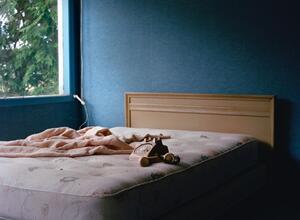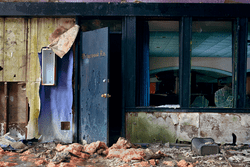An Interview with Photographer Marisa Scheinfeld: Part I
This year, photographer and Catskills native Marisa Scheinfeld mounted her first museum exhibit, “Echoes of the Borscht Belt.” We spoke to Marisa about her haunting photographs, what drew her to the ruins of the famed Jewish play land, and why the Catskills are so important to Jewish American culture.
From the 1920s to the 1960s an area of the Catskills, also known as the Borscht Belt, boasted hundreds of hotels and resorts. It was the vacation destination for Jewish Americans, but has fallen into decline and disrepair over the last few decades. What do these resorts look like now?
According to the Catskills Institute, the Borscht Belt was comprised of over 1,172 hotels and 849 bungalow colonies. Many of these former hotels and colonies have been reclaimed and restored. Some are now meditation centers, others are rehabilitation centers, and many are Orthodox hotels and bungalow colonies. My project focuses on the hotels and colonies that have been abandoned – with a period of stagnation, or lack of development, ranging from five to twenty years – where nothing has happened for a variety of reasons and circumstances. Each hotel or colony presents a different story of when it closed, why it closed, and who currently owns it.
Tell us about your project, “Echoes of the Borscht Belt.”
The project brings up notions about the nature of time and change—what happens not only to people over time, but to the place and space itself. When I began working on it, many people would question me and say, “Why do you want to go in those places? There’s nothing there.” On the contrary, I have discovered, via the three-dozen Borscht Belt sites I’ve photographed, that there is in fact something there. I’ve found an ever-evolving landscape that has drawn me back multiple times, in all seasons. Each time I revisit a hotel or colony, much of the adventure lies in the fact that I don’t know what I’m going to find.
Some of my images highlight the stark contrast between the past and present: a row of mint-green stools lined up before a phantom lunch counter that was removed long ago; a dining room that local kids have commandeered for paint-gun battles; a quiet guest room with an unmade bed and phone lying off the hook. In other images, nature that has assumed full control: moss climbs the walls; plants grow through floors; and carpet that was once green has turned to moss, almost as if you cannot tell where the man-made ends and the nature-created begins.
How important were the Catskills to Jewish American life? Is there continued significance in the sites?
The Catskills were the preeminent destination for tens of thousands of predominantly East Coast American Jews from the 1920s through the 1960s. About 90 miles northwest of New York
City, the region was internationally known as a summer retreat for entertainment and leisure. For more than 45 years, it reigned supreme in the Jewish American experience, and exerted a strong influence on popular Jewish American culture and imagination. Known as the Borscht Belt for an inclination toward Eastern European cuisine, the resorts of Sullivan and Ulster County combined recreational activities with nighttime entertainment – especially stand-up comedy, which was born in the region’s theaters and showrooms. At its peak during the post-WWII era, the Borscht Belt sustained more than one thousand hotels, as well as hundreds of bungalow colonies and summer camps.
Banned from many hotels in the 1920s and 1930s, Jews were attracted to the Borscht Belt not only by its easy access, full amenities, lush setting and top-notch entertainment, but also by the promise of being part of a familiar and sympathetic community. In its hotels and bungalow colonies relationships were forged and social bonds developed; its culture came to define aspects of the post-War Jewish American experience, extending into mainstream American life.
In the 1970s, with the lower cost of air travel, shifts in demographics, and changes in taste, the Catskill resorts diminished in popularity. By the 1980s, when I was growing up in the region, much of the Borscht Belt industry had waned and many of its hotels had closed – a process that continued in the following decades.
Tell us more about your personal connection to the Catskills.
Growing up in Sullivan County in the 1980s, there was always a family member, friend, or local resident quick to tell a story about the area’s boom times. Tales of the Borscht Belt were practically unavoidable during car rides or at the dinner table. I, too, have my late Borscht Belt-era stories, and I vividly recall visiting many of the famous hotels on weekends with my grandparents (who met, by the way, while my grandmother and her sister were hitchhiking on one of the winding roads of Sullivan County).
My parents and I would go to hotels such as Kutsher’s or The Concord to visit my grandfather in card rooms redolent with the scent of cigars, and afterwards swim in one of the massive pools or play a game of bingo. As a teenager, one of my first jobs was as a lifeguard at The Concord, which closed soon after, in 1998. The region connected not only my own family but also an incalculable number of other families. The mere mention of the Borscht Belt to this day conjures up myriad memories, animated stories, and emotive feelings for all who passed through it. As a result, I believe its significance, even if lost in a sense of physical place, remains in the psyches of many, and surely resides in a space of historical and cultural importance.








